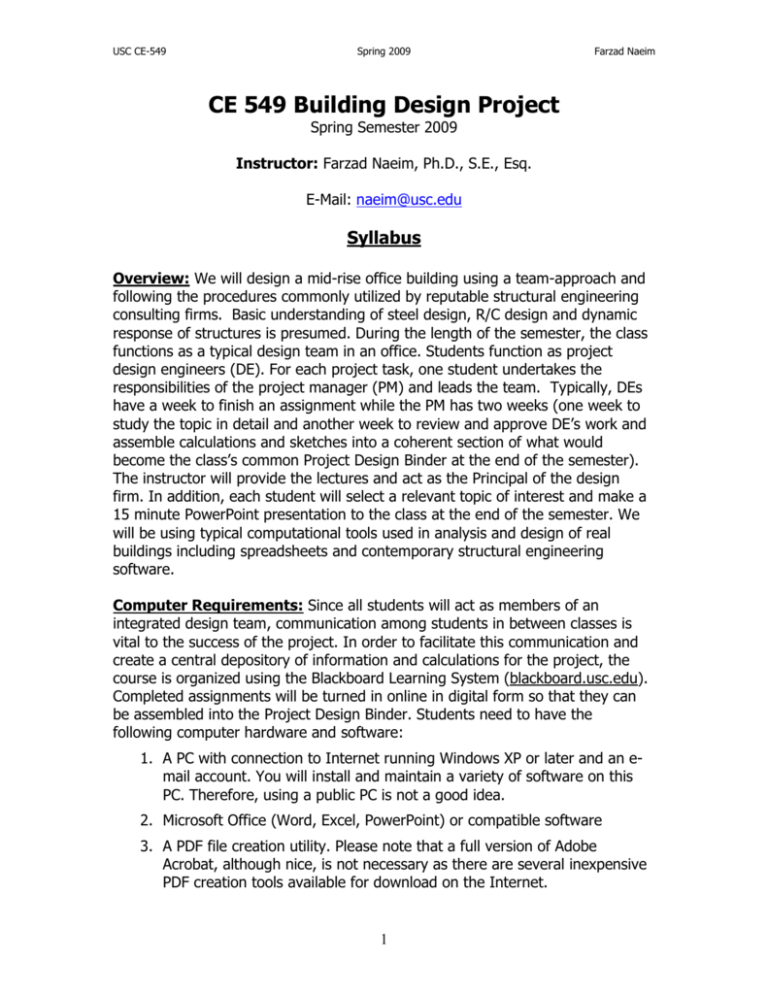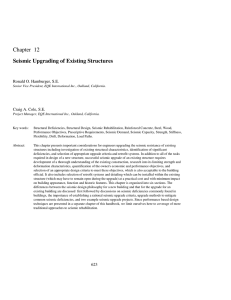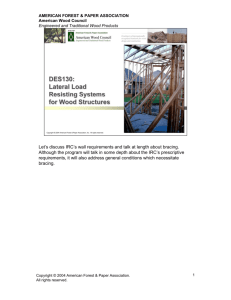CE 549 Building Design Project
advertisement

USC CE-549 Spring 2009 Farzad Naeim CE 549 Building Design Project Spring Semester 2009 Instructor: Farzad Naeim, Ph.D., S.E., Esq. E-Mail: naeim@usc.edu Syllabus Overview: We will design a mid-rise office building using a team-approach and following the procedures commonly utilized by reputable structural engineering consulting firms. Basic understanding of steel design, R/C design and dynamic response of structures is presumed. During the length of the semester, the class functions as a typical design team in an office. Students function as project design engineers (DE). For each project task, one student undertakes the responsibilities of the project manager (PM) and leads the team. Typically, DEs have a week to finish an assignment while the PM has two weeks (one week to study the topic in detail and another week to review and approve DE’s work and assemble calculations and sketches into a coherent section of what would become the class’s common Project Design Binder at the end of the semester). The instructor will provide the lectures and act as the Principal of the design firm. In addition, each student will select a relevant topic of interest and make a 15 minute PowerPoint presentation to the class at the end of the semester. We will be using typical computational tools used in analysis and design of real buildings including spreadsheets and contemporary structural engineering software. Computer Requirements: Since all students will act as members of an integrated design team, communication among students in between classes is vital to the success of the project. In order to facilitate this communication and create a central depository of information and calculations for the project, the course is organized using the Blackboard Learning System (blackboard.usc.edu). Completed assignments will be turned in online in digital form so that they can be assembled into the Project Design Binder. Students need to have the following computer hardware and software: 1. A PC with connection to Internet running Windows XP or later and an email account. You will install and maintain a variety of software on this PC. Therefore, using a public PC is not a good idea. 2. Microsoft Office (Word, Excel, PowerPoint) or compatible software 3. A PDF file creation utility. Please note that a full version of Adobe Acrobat, although nice, is not necessary as there are several inexpensive PDF creation tools available for download on the Internet. 1 USC CE-549 Spring 2009 Farzad Naeim Textbooks: A useful book to have for this class is: Williams, A., Seismic and Wind Forces Structural Design Examples, 3rd Edition, International Code Council, 2006. Two other books that are helpful and you can also draw on for your individual presentations are the following which will be distributed to students at no charge Designing for Earthquakes – A Manual for Architects, FEMA 454, Federal Techniques for the Seismic Rehabilitation of Existing Structures, FEMA Emergency Management Agency, 2006. 547, Federal Emergency Management Agency, 2006. Grading: Attendance and Participation: 5% Project Assignments: 75% PE work PM work 50% 25% Final Exam (consisting of an Individual Study and PowerPoint Presentation): 20% Quizzes: Extra Credit Class Schedule: Week No. 1 2 3 Date Subject(s): Welcome to Building Design Project: Overview of the project we will be working on; governing codes and standards; project participation process; design criteria; table of content and format of the Project Design Binder; 01/12/09 communication protocols; design office procedures from job procurement to final design; importance of good engineering and consequences of bad engineering; the tools of the trade; current practice versus current state of knowledge 01/19/09 No Class Preliminary Design: back of the envelope calculations and rules of thumb for proportioning structural members and 01/26/09 systems; preliminary sizing of steel and concrete beams; columns and various floor systems; formulas for estimating lateral displacements and drift control for moment frames; 2 USC CE-549 4 5 6 7 8 9 10 11 Spring 2009 Farzad Naeim braced frames and walls. Fundamentals of Structural Dynamics: Review of necessary dynamics concepts such as periods, mode shapes, response spectrum and design spectrum. Gravity Design I (steel construction alternative): Dead and live loads; ASCE 7-05 definitions; 2006 IBC load combinations; the concept of sustained load; tributary area 02/02/09 and load path; design of steel flexural members; composite floor system; design of composite floor deck, beams and girders; column load rundown to foundations and sizing of gravity columns; introduction to deformation compatibility Gravity Design II: (serviceability and other issues): floor vibration from human activity; design for human comfort 02/09/09 due to walking and rhythmic activities; deflection control; diaphragm openings; beam and girder web openings; steel gravity connections 02/16/09 No Class Lateral Design I: Introduction to wind and seismic effects; ASCE 7-05 wind load distributions; ASCE 7-05 seismic design criteria; horizontal and vertical irregularities; occupancy and seismic design categories; design wind and seismic forces; static and dynamic distribution of forces; 02/23/09 foundation issues; 2006 IBC load combinations for wind and seismic effects; special seismic loads and design coefficients; R, Cd, and 0 factors; height limitations; site conditions; base shear and shear distribution over the height; diaphragm forces Lateral Design II (Design of Steel Special Moment Frame Alternative): Review of past performance of SMRF systems; principles of SMRF design; pre-qualified connections; 03/02/09 reduced beam section (RBS) connection; design of RBS systems; strong column – weak girder requirement; drift design; P- effects and their importance; proper methods for consideration of P- effects; foundation issues Lateral Design III (Design of Concentric Braced Frame Alternative): Description and types of Concentrically Braced Frames (CBF); behavior of CBFs; AISC Seismic Provisions 03/09/09 for Special CBFs; developing ductile behavior in CBF; overturning and overall stability; forces in beams, columns, and braces; design of connections; foundation issues 03/16/09 No Class 03/23/09 Lateral Design IV (Design of Eccentric Braced Frame 3 USC CE-549 Spring 2009 12 03/30/09 13 04/06/09 14 04/13/09 15 04/20/09 Farzad Naeim Alternative): Description and types of Eccentric Braced Frames (EBF); behavior of EBFs; AISC Seismic Provisions for Special EBFs; shear link behavior; link plastic rotations; proportioning EBFs; design approach for EBFs; forces in beams, columns, braces and the shear link; design of brace and shear link; design of connections; foundation issues Gravity Design III and Lateral Design V (Concrete construction alternatives): Floor slab alternatives; R/C or PT?; ACI 318-05 provisions; common methods for design of R/C and PT floor slabs; advantages and disadvantages of each system; design of slab and beam R/C floors; Design of PT flat plate floors; significance of punching shear; solutions for punching shear problem; design of members for flexure, axial load; shear and torsion; reinforcement selection; development of reinforcement; foundation issues Lateral Design VI (RC Seismic Detailing): Behavior of R/C frames and walls; P- effects and their importance; 2006 IBC and ACI 318-05 provision for seismic design and detailing of R/C frames and walls; significance of confinement; longitudinal and transverse reinforcement details; precast options; seismic detailing of slabs; strong column – weak girder requirement; columns supporting discontinued stiff members; foundation issues. Lateral Design VII (Seismic Design of Floor Diaphragms): The role of a diaphragm in a building; diaphragm classification; rigid, flexible and semi-flexible diaphragms; collectors, chords and drags; diaphragm design procedures; diaphragm deflections; diaphragm modeling issues; potential diaphragm problems Foundation Design: Overview of foundation alternatives; design of spread footings; design of combined footings; design of grade beams; design of piles and pile caps; design of mat foundation; an introduction to soil-structureinteraction and its impact on response of the building 16 17 04/27/09 05/04/09 No Class 18 05/11/09 Putting it all together Final Exam / Student Presentations 4 USC CE-549 Spring 2009 5 Farzad Naeim







